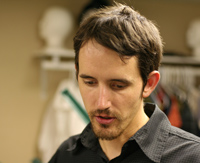Adam Stallard

How did you get started with New Play Project?
My sister liked to act at BYU, she’d done several shows there, and she saw the audition flyer for the show by the Nelke. She auditioned and dragged her fiancé to auditions, and the two of them got cast in A New Leaf.
I think she wrote an email to Bianca, just letting them know that I existed and that I might be interested. At the time I wasn’t doing any plays, I was just involved with a comedy improv club, and that was it, so I had the time. When my sister forwarded an email from Bianca, I found out that they did original plays.
So the next day after I got that email, I just showed up at workshop, which kind of surprised Bianca. I guess we don’t get a lot of new, random people showing up. They were workshopping one of Mary Heaps’ plays, Trapped, and I thought it was a great play. I got to read one of the parts and it was a really fun experience. I thought, “This must be a cool organization.”
I immediately started asking, “Is there anything you need help with? Is there anything else I can do for you?” James Goldberg told me that they needed someone to transport cinder blocks—because in those days, we laid out cinder blocks and put planks of wood over the top of them and set that up in the Provo Library, performing our plays on that makeshift stage. So my job was to load those into a truck and unload them and form them into the stage. And I did that every night, for every performance for A New Leaf.
I auditioned for the next show, Beneath the Surface, and ended up acting and assistant directing. I had never directed before, but I enjoyed it—it was a fun, new experience for me. Ever since then I’ve been acting in and directing a lot of the plays. And I’ve done some writing, too.
What was it like writing Irrational Numbers?
That was an interesting experience because it got accepted as an outline. A lot of that play is an outline—a lot of the actual script is these interjections that the daughter makes, telling the story of the Pythagoreans. I knew that something relevant to each of those sections had to go in between, but I didn’t know what it was.
I just started writing, started pouring out tons and tons of dialogue. I didn’t know exactly how it was going to fit, but I knew I needed to get something out, so I just started writing tons of dialogue between the mother and the daughter, and the daughter and the husband.
And then I took that to workshop and said, “Guys, I’ve got lots of pages of dialogue. I don’t know what to do with it.” James suggested that we take scissors and cut up the dialogue. We tried it in different places, we said, “What if we put this dialogue in front of this dialogue? What if we put it in this section?” and we tried it in different places till we liked it. We found the pieces that were necessary and the pieces that weren’t. Some of it got scrapped, a lot of it got used, we figured out where it should go.
That pretty much is how the play got written. It was a group effort, a collage of dialogue that fit within this frame of the Pythagorean story.
What do you do now for NPP?
I’m the managing director. Basically, I do whatever I think is going to improve our situation organizationally. So I’m in charge of finding ways to get new volunteers, increase audience awareness, get more audience, make sure that we’re solid financially—everything that is going to keep us going in the long run. And I invent a lot of jobs and hand them out to other people.
How do you see NPP affecting and influencing the Mormon arts world?
Well, I think James Goldberg put it best when he said that we have a chance to have a Renaissance of our own, a voice of our own in the world. There’s a lot that unites us as Latter-day Saints, and being able to express things that are uniquely ours, having them be valid rather than having to tone this down or take that out because we’re trying to appeal to other audiences, having an audience that understands that, and being able to write to them, and just being able to use our own culture in our art, I think is really important. ❧
